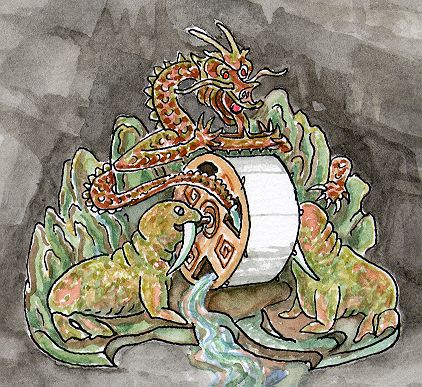
 |
The second Seismograph of Chang Heng |
A tragic demonstration of the difference between temperature and heat
and a tribute to Gaël de Guichen on the occasion of his retirement from the International Centre for the Study of the Preservation and Restoration of Cultural Property in Rome (ICCROM)
I first met Gaël de Guichen on an aeroplane rising into the sky over Texas. The thin, soberly dressed man by the window had given me a nod as I took my seat and spoke a greeting in a distinctly French accent. I had no reason to think him anything but a typical, slightly nervous member of the international flying class. But as soon as the plane rose from the runway I became alarmed as he pulled a device from his bag and started waving it energetically in a circular movement above his head, spraying me with drops of a cool liquid. The unnatural vigour of his movements also attracted the notice of the cabin staff, who converged on the source of disorder. By the time they had arrived I had calmed down, because I recognised that my companion was no madman but a mad scientist. His weapon was a sling psychrometer, a device for measuring relative humidity, of great antiquity and adequate accuracy.

It took some time for my neighbour to persuade the cabin crew that he was performing a harmless experiment. I had meanwhile extracted my electronic hygrometer, a measuring device better suited to timid travellers, of no antiquity and unreliable accuracy. In this way I met Gaël de Guichen in a typically dramatic situation, of his own making.
The explanation for his animated behaviour turned out to be entirely rational, by Gaël's standard. He had been giving one of his now celebrated courses in preventive conservation, in La Paz, Bolivia. At the end of the course, as he was checking on the swinging style of the students, one of them, a tribal elder dressed in a colourful knitted cloak, suddenly broke his week long silence: 'Excuse me, but I don't think you applied the correction for the low atmospheric pressure up here'.
As the plane ascended we compared the signals from the psychrometer and from the electronic hygrometer, whose indication should be independent of air pressure. Since the relative humidity in the cabin rather quickly dropped close to zero we were unable to complete the experiment convincingly and fell to talking about other shared interests.
My journey was connected with an insurance claim for damage to a unique Chinese bronze that had been lent to a special exhibition of ancient scientific instruments.
The story behind the making of the bronze antiquity is rather interesting. The celebrated Chinese scientist of the first century of our Western era, Chang Heng, had already made an elegant seismograph, which, when vibrated, released a ball from the mouth of one, or several, dragon heads attached to the circumference of a bowl. Chang Heng likened the universe to an egg, with the earth as its yolk. Earthquakes were caused by movement of the semi liquid yolk. Chang's rival for scientific recognition at that time was Li Pao. Li had a different theory: that earthquakes were the vibrations from meteorites hitting the earth in remote places.
Li and Chang agreed to build a set of instruments to decide the matter. They combined two inventions by Chang Heng: the seismograph and a water driven armillary sphere, to make a bronze dragon embracing a water driven cylinder, also in bronze, whose circumference was covered with plates of porous porcelain. In the dragon's mouth they balanced a delicate glass bulb which was filled with ink.
Several of these devices were made, and placed far apart throughout China. They reasoned that a spasm at the centre of the earth would dislodge all the ink bulbs at about the same time, whereas the waves from a meteorite impact would first dislodge the nearest bulb.
The bulb would fall and shatter in a cunningly shaped nib, which allowed a slow flow of ink that dripped onto the slowly rotating cylinder from a slowly changing point (a refinement that would be useful in modern thermohygrogaphs). After an earthquake, horsemen would race to the various seismographs with coordinated timepieces, which Chang would certainly have designed with the necessary accuracy. On arrival at the site they would measure the length of the trace and thus test whether there was a systematic time delay between the records of the event at the different places.

The seismograph of Chang Heng and Li Pao, installed in a grotto in the mountains. The white porcelain cylinder rotates slowly under water power. When an earthquake shakes the mountain the glass sphere containing red ink falls from the mouth of the dragon into the trough held between its forefeet. The glass shatters against a bronze spike. The ink dribbles slowly from the trough onto the rotating cylinder in a spiral pattern.
We have, unfortunately, no record of the result of this experiment, though from modern knowledge we would expect the data to support the wrong theory.
There is only one known surviving seismograph, with an intact ink bulb until the event I will now recount.
The massive bronze dragon and water wheel were packed in one case and the delicate glass ink bulb in another. The cases were made according to the best modern advice, with humidity buffer and thermal insulation within a strong outer case liberally decorated with pictures of wine glasses, arrows and written messages urging care, in several languages. Furthermore, the conscientious conservator had put data loggers in both packages. A logger for temperature and relative humidity to inform about the climate around the bronze, but only a vibration logger attached to the outside of the package containing the bulb, because she considered mechanical damage the only threat to the glass bulb and was fearful that a second logger, for temperature and RH, might break loose inside the package, in which the sensitive bulb was suspended by wires and springs within a generously sized cage.
On arrival and unpacking, the conservator's tears were as abundant, but not as brightly coloured, as the splashes of ink that stained the inside of the container. Delicate shards from the shattered bulb lay among the glistening drops of ink.
The ink was immediately sent for analysis to the Smithsonian Institution's Conservation Analytical Laboratory, as it was then known. The data logger records were examined for clues to the tragedy.
During the flight over the Atlantic the boxes were stowed in one of the aircraft's cargo holds. The box with the bronze had fallen in temperature from twenty degrees to about seven degrees, the relative humidity had shown the usual small drop and fast recovery on take off, with a corresponding rise and recovery on landing, but was otherwise stable. The vibration recorder showed no evidence of unusual vibration or shock. The spring suspension system was intact, with no evidence that the bulb had swung against the walls of the enclosure.
The distraught conservator could not explain what had happened and the newspapers were soon pepping up their accounts of the disaster with references to centuries old curses on those who tampered with dragons by taking coloured sweets from their mouths. American diplomatic relations with the People's Republic of China became more than usually strained as protest notes arrived, railing at Western vandalism against treasures stolen from the ancient Empire in the Middle by British and French armies in the nineteenth century.
Gaël had been listening attentively to my story, clutching the immobile psychrometer absent mindedly in his lap, while the water from the wick seeped into his trousers. Now he again became animated. His incisive, scientific mind saw immediately what had happened: the temperature in the aircraft hold had fallen much more than indicated by the data logger within the box. It must have fallen below the freezing point of water: the delicate glass bulb had surely been burst open by the freezing expansion of the watery ink .
The safe temperature indication from the box containing the bronze could not be applied to the other box, because the massive bronze would have buffered the temperature. Much heat would have to pass through the insulation to lower the temperature. The tiny glass bulb, however, had little heat capacity, and was in a relatively large case, to allow it to swing, softly constrained by the thin wires and compliant springs, which had scarcely any heat capacity. The same amount of heat leaking through the generous area and identical thickness of insulation would cause a much greater drop in temperature of the small glass bulb.
Gaël and I spent the rest of the journey lamenting conservators' general lack of a sense of the magnitudes of the various threats to the treasures in their charge. They spend (this was several years ago) all their energy discussing the threat of relative humidity change during journeys and stuff data loggers into the boxes. The relative humidity will hardly change at all, if the object is wrapped first in a single layer of paper and then in impermeable plastic, because the layer of absorbent material around the object will buffer the relative humidity in the confined air. Heat movement, on the other hand, is impossible to stop altogether and is therefore a much more serious threat to an object in transit.
The years have passed and Gaël and I have seen each other at rare intervals, mostly at conferences. I have admired his incisive grasp of microclimatic principles, often applied to subterranean rather than stratospheric problems: from the Lascaux grottos to Nefertari's tomb. Later, as Gaël became known as a spirited and entertaining teacher, I admired him for realising, before most of us, that we don't need more research in preventive conservation nearly so much as we need to teach people to understand, and then to apply, what we already know.
The next part of this article is a more formal dissection of the thermal aspects of transporting art.

This work is licensed under a Creative Commons Attribution-Noncommercial-No Derivative Works 3.0 License.